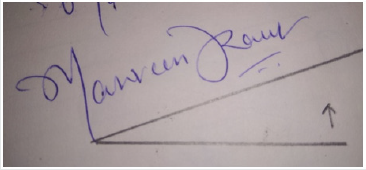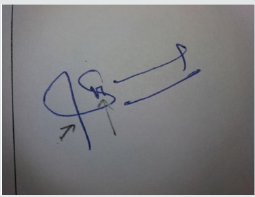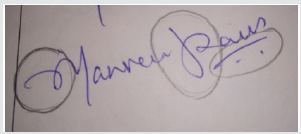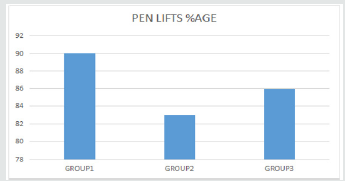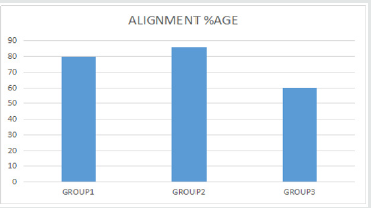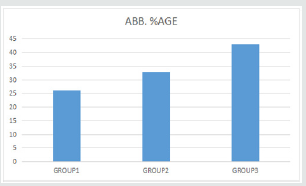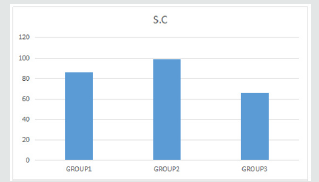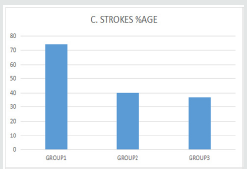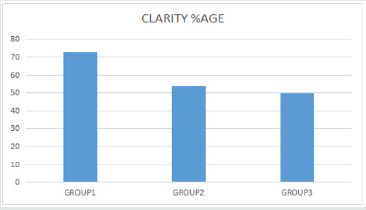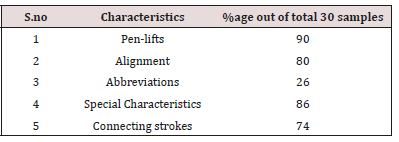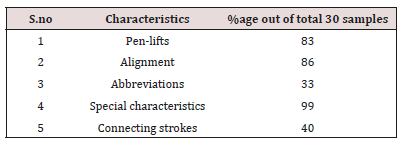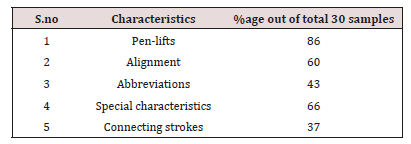
Lupine Publishers Group
Lupine Publishers
Menu
ISSN: 2638-6062
Research Article(ISSN: 2638-6062) 
Analysis of Signature Features in Different Age Groups Volume 3 - Issue 2
Harshdeep Singh, Priyanka Verma*, Anita and Navjot Kaur
- Department of Forensic Science and Toxicology, Punjab, India
Received:March 05, 2019; Published: March 14, 2019
*Corresponding author: Priyanka Verma, Department of Forensic Science and Toxicology, Institute of Applied Health Sciences, Gharuan, Punjab, India
DOI: 10.32474/PRJFGS.2019.03.000160
Abstract
Questioned document is very integral part of forensic science. Signature analysis comes under this branch of forensic science. This research has been conducted to relate the signatures with the age which may help in establishing the authorship or contribute in establishing. An understanding of signature features and fashion of their variation in signatures of the individual’s ranging from 14 to 60 years of age by dividing them into three different group (i)14-20 years (ii)21-30 years (iii)31-60 years with the comparative study based on those signature features among the three different groups stated. The signature samples from the individuals were collected on the sample sheet. Highlight of our study was, that no such significant relation was present in between the signature features and their fashion of variation in signature with change in age of the specimen.
Keywords:Signatures; Signature analysis; Signature features
Introduction
Forensic science is the field of science, in which we apply the knowledge of science to the obtained evidences from the crime scene, to examine, and to identify the suspect. In forensic science, there are many branches which deal with different types of evidences, and questioned documents is one of the branches, which deals with examination of documents obtained either from the victim, or the crime scene or from the old records. Further, scientific methods are applied as well as our scientific knowledge is applied to the documents obtained for the further analysis, in order to have a significant information to have a lead in our cases. Documents obtained as evidences might be deliberately altered, undergone changes, damaged, forged, and related questions which arises in the court [1].
In day to day life, people do their signatures on various documents like entry registers, cheque, forms, etc. Generally, individual on daily basis perform same activities. Therefore, mostly questioned documents include signature forgery, thus we can say that signatures are very important in examining questioned documents. A signature is basically a handwritten text or kind of drawing of someone’s name, or even a letter or symbol that a person writes on documents as a proof of his or her identity with an intent. The writer of a signature is a signatory or signer. A signature is somewhat like a handwritten of that individual, so we can say that a signature reflects someone’s handwriting or drawing pattern [2].
The function of a signature is to unalterably stick to a document a person’s uniquely personal, undeniable self-identification as physical evidence of that person’s personal witness and certification of the content of all, or a specified part, of the document. For example, the role of a signature in many consumer contracts is not only to provide evidence of the identity of the contracting party, but also to provide evidence of informed consent and deliberation [2]. Just like fingerprint which bears individuality of the person just like that signatures also holds importance place in the field of forensic science, generally signatures are related to the person’s behavioural characteristics, thinking, attitude, personality etc. which means signatures not only tell us about name of the authority or person but also gives insight of the person character, trait, personality also [3].
Research which had been conducted before on handwriting, drawing and signatures had given as follows
a.Various methods and techniques have been introduced by researchers for the purpose of identification and verification of the hand-written signature of an individual by the help computer software [4,5].
b. With increase in age and other changes in life collectively effects the mind, body, motoric skills also which can be observed from an individual’s hand writing, drawing and signatures [6,7].
c. Analyses of handwriting and signature with help by applying kinematics [8,9].
d. Difference in speed of handwritings in males and females of different ages [4,5,9].
e. Handwriting features analyses individuals who are Parkinson disease and depressed patients [8,10].
So, with this we can also say that there will be variations in signatures design of a person with increase in age and addition to that we can also say that hand written signature can also give us an idea about the age of that person, or we can have a rough estimate of an age from his or her handwritten signatures? As from the research work conducted before had mainly focused on age and handwritings in order to have insight whether age effects the hand writing patterns or not in different age groups.
Methodology
Collection of Samples
a. Subject was settled and then their signature samples were collected on a sample sheet.
b. Five to six signature samples from ball point pen were collected for each subject with their consent.
c. Total 90 samples were collected, they were grouped into different groups according to the age of the individuals.
Inclusive Criteria
Following considerations were kept in mind while including individuals:
i. All the individuals who are well educated (including housewives).
ii. All the individuals who had good knowledge of English language.
iii. All the individuals who do their signatures in Roman.
iv. All the individuals who sign from very less to very often.
Exclusive Criteria
Following considerations were kept in mind while excluding individuals:
i. All the individuals who are not well educated.
ii. All the individuals who have less knowledge of English language.
iii. All the individuals who do their signatures in any other language or form besides Roman.
iv. All the individuals who use their thumb print in the place of signatures.
Analysis of Samples
Samples were first grouped in accordance with-:
I. 14- 20 years
II. 21 -30 years
III. above 30 years
Individually all samples were observed based on following parameters:
a. Pen lifts.
b. Alignments.
c. Abbreviations.
d. Special characters.
e. Connecting strokes.
f. Clarity of alphabets in signatures.
Pen Lifts
Pen lifts are defined as habit of lifting the pen from surface at the time of writing. Usually it means that the pen has been entirely lifted from the paper as that effect on the paper results in a break in a continuous line that represent part or all a letter or sequence of letters in signature. During analysis of pen lifts in signature samples special attention was given whether there are pen lifts or not like in Figure 1, in every person’s signature and the occurrence of these pen-lifts among the group was seen. Out of total numbers (30 samples in each groups) samples, percentage of signatures with pen-lifts was then calculated in all the three groups respectively.
Alignment
Alignment is an arrangement in a straight line or in correct relative positions. We have looked for the alignment in which signature starts from the lower end and terminates at the higher end, higher elevation of the terminal end was preferred. Out of total numbers (30 samples in each groups) of samples, percentage of the signatures with that alignment was then calculated in all the three groups respectively Figure 2.
Abbreviations
Generally, abbreviation is defined (here) as employment of short form for the convenience by using first initial alphabet of first name or second name or middle name in the signatures like in Figure 3. So, trends of using abbreviations was observed in three of the groups respectively. Out of total numbers (30 samples in each groups) of samples, percentage of signatures with abbreviation(s) was then calculated in all the three groups respectively.
Special Characters
When any character other than letters is incorporated it is known as special characters for example- stars or dots (other than ‘I’ dots) or drawing or an artistic stroke(s) fused with any alphabet(s). There were various special characters that were present diversely in the all signature samples imparting every signature its own uniqueness. So, all signatures were analysed by only giving the preference that whether the signature possess any special character(s) or not. Out of total numbers (30 samples in each groups) of samples, percentage of signatures with special character(s) was then calculated in all the three groups respectively Figure 4.
Connecting Strokes
Connecting strokes are the extended tails of a letter which connect them with each other, they bridge up letters of name in signature. Our analysis was concerned about whether alphabets present in the signature samples are clear or not, with connecting strokes or not. From those further depiction of name was seen like in Figure 5. Out of total numbers (30 samples in each groups) of samples, percentage of signatures in which the criteria mentioned for the connecting strokes were present was then calculated in all the three groups respectively.
Percentage of Clarity of Alphabets
Those alphabets which are clearly readable from the signatures which will further also give us an idea of the name from the signatures. It was calculated as: -
TOTAL NUMBER OF ALL CLEAR CHARATERS IN SIGNATURE × 100
TOTAL NUMBER OF ALL CHARACTERS INSIGNATURES
For example, there are total eleven clear and unclear characters or alphabets out of which eight alphabets are clear i.e. ’m’, ’a’, ’n’, ’v’, ’e’, ’k’ and ’r’, according to formula (8/11 x 100 = 72.72%)we can say that nearly 72% of clarity of alphabets in the signature is present. Convention used while counting total alphabets:
a. While looking for the clear and unclear characters seen whether name from signature was visible or not for just to had rough estimate about the possible alphabets used by the person in his or her signatures.
b. Clear alphabet was given complete count and named as clear character. For each clear alphabet one count was added.
c. Alphabets which were mixed with one another alphabet, alphabet which was appeared to be complete beside being mixed with other alphabet was given complete count and another alphabet which mixed was given a half count with respect to clarity.
d. While counting for the total characters those partially formed alphabets or different shapes of alphabet which were confusing to judge were given complete count respectively and termed as non-clear character. And then they were added with total counts of clear characters present in the signature.
e. If each alphabet in signature was clearly visible with proper shape and design than 99% clarity was considered in signature.
f. If no alphabet is clear 1% of clarity was considered in the signature.
g. After calculating the individual percentage of clarity total mean of all percentages in all three groups were then calculated which was tabulated (in chapter of observations and results) and further from that for more understanding a bar graph was prepared (in chapter of observation and results).
Observations
Pen Lifts
In the Figure 6, graph shows the percentage of pen lifts in three different age groups. It is abundantly found in group 1. Followed by group3 and 2. People from group 1 do not sign frequently we can say so; they show a greater number of pen lifts.
Alignment
In Figure 7, refers to the fashion of signature ascending upwards towards its side which is greatly shown by group 2. Other two groups have been deviated from the sample alignment that has been considered.
Abbreviations
The Figure 8, graph shows that abbreviations used by people of group 3 are more than the other two groups with group 1 being the least. As group 3 people tend to sign very frequently, they try to save time by using abbreviations in their signature.
Special Characteristics
In Figure 9 Group 2 was one with the highest percentage of individuals who uses special characters in their signatures. As more than 50% of people in a sample space of 30 of each group have been observed to use special characteristics which may differ in a bigger sample space.
Connecting Strokes
In Figure 10, Connecting strokes have been clearly observed more in group 1 as they write on daily basis so show their handwriting features here. But again, as there is no significant difference in group 2 and group 3.
Clarity
In Figure 11, Most of the alphabets used in signatures were clearer in group1 than the other two groups. As people from group 1 write frequently so they form letters clearly.
Results and Discussion
On the basis observations mentioned in previous chapter the following results from the observations were observed:
Table 1 showcases the percentage value observed in group 1 i.e. 14 to 20 years. Above calculated percentages were calculated out of 30 samples which were taken in account for the study in this group. Out of 30 samples there were 90% of samples were with penlifts, 80% of the samples were having alignment that was heading upward in direction as signature ends ,26% of samples had used abbreviations ,86 % of the samples had special characters and 74% of connection strokes with clear formation of alphabets.
Table 2 showcases the percentage value observed in group 2 i.e. 21 to 30 years. Above calculated percentages were calculated out of 30 samples which were taken in account for the study in this group. Out of 30 samples there were 83% of samples were with penlifts, 86% of the samples were having alignment that was heading upward in direction as signature ends ,33% of samples had used abbreviations ,99 % of the samples had special characters and 40% of connection strokes with clear formation of alphabets.
Table 3 showcases the percentage value observed in group 3 i.e. above 30 years. Above calculated percentages were calculated out of 30 samples which were taken in account for the study in this group. Out of 30 samples there were 86% of samples were with pen-lifts, 60% of the samples were having alignment that was heading upward in direction as signature ends ,43% of samples had used abbreviations ,66 % of the samples had special characters and 37% of connection strokes with clear formation of alphabets.
In the Table 4, average percentage regarding clarity in signatures of respective groups were showcased. The percentage displayed in the table is an average mean percentage out of 30 samples of respective groups. Firstly, the individual percentages of clarity were calculated for each signature sample and then average percentage of clarity among 30 samples of each group was determined.
The study resulted that:
a) Pen lifts in three different age groups, abundantly found in group 1. Followed by group3 and 2. People from group one does not sign frequently we can say so; they show a greater number of pen lifts. But also pen lift is a characteristic of handwriting, so people belonging to any age group can possess it.
b) The fashion of signature ascending upwards towards its side which is greatly shown by group 2 followed by group 1. There is a very less chance to differentiate between group 1 and 2 so this factor too is less insignificant to specify age groups
c) Abbreviations used by people of group 3 are more. As group 3 people tend to sign very frequently, they try to save time by using abbreviations in their signature. But this factor is insignificant if we link it to age as it was found that people with a long name too tend to use abbreviations and they can belong to any age group.
d) The most common characteristic observed was underlines followed by dots. There were mixed characteristics too. Group 2 was one with the highest percentage. As more than 50% of people in a sample space of 30 have been observed to use special characteristics which may differ in a bigger sample space.
e) Connecting strokes have been clearly observed more in group 1 as they write on daily basis, so they show their handwriting features. But again, as there is no significant difference in group 2 and group 3 this factor too has not been successful for the study conducted.
f) Most of the alphabets used in signatures were clearer in group1 than the other two groups. As people from group 1 write frequently so they form letters clearly. This factor too does not show very significant difference.
Various method in systems were developed and introduced by the experts and the researcher’s regarding identification and verification of hand-written signatures. In present study various handwritten signatures were analysed in order to observe various features in them. And to study this, the age factor was divided into three groups. Eventually seven features were chosen during the study.
The points which has limited the study were pondered as follows:
a. All the subjects from whom samples were collected, were educated and had knowledge of Roman alphabet’s and basic English.
b. They all have been practicing handwriting since they were in school.
c. Some were frequent writers of their signatures and some were not.
d. Only those signatures were studied which were done in English Roman literature.
e. Assumptions were made that, subjects were healthy at the time of giving sample and were not under any influence any drugs and alcohol.
f. Signature sample from younger subjects (< 14 years) were not considered to be studied. And majority of the sample in group 1 were of subjects 18 and19-year-old.
g. If any subject used any other alphabet other than the Roman character’s, those were considered as special characters.
Conclusion
It is concluded from the given study that features which were observed were having similar occurrence among the age group which were desired to studied. Most of the features found were common in all groups. No significant variation in features were seen which were chosen with the thought that they will change with an aging and these changes will be evident in signatures but no such variation in features was found among the groups. While studying no significant difference among features were observed beside percentage clarity which had shown significant difference with respect to other two groups but no significant difference among them. Hence it is recommended more need of deeper study and methods are required in this field of interests computerized or software-based study will harvest more satisfactory outcomes regarding this type of study as there will be features which can only be analysed with help of software only. At last we can say that from only studying features of signatures one cannot estimate the age of an individual from his or her signatures and addition to it more work can be done in this area for deeper understanding in the desired area of interest [11-22].
References
- Nabar BS “Forensic Science in Crime Investigation” (5th edn).
- https://en.wikipedia.org/wiki/Signature.
- https://handwritingfoundation.org/introduction-to-graphology/
- Kekre HB and Bharadi VA (2010) Gabor Filter Based Feature Vector for Dynamic Signature Recognition. International Journal of Computer Applications (0975-8887) 2(3): 74-80.
- Mahanta L and Deka A (2013) A Study on Handwritten Signature. International Journal of Computer Applications (0975-8887) 79(2): 48-52.
- Rueckriegel SM, Blankenburg F, Burghardt R, Ehrlich S and Henze G (2008) Influence of age and movement complexity on kinematic hand movement parameters in childhood and adolescence. International Journal of Developmental Neurosciences 26(7): 655-663.
- Van Drempt, McCluskey A, Lannin NA (2011) A review of factors that influence adult handwriting performance. Australian Occupational Therapy Journal 58(5):321-328.
- Mergl R, Juckel G, Rihl J, Henkel V, Karner M, et al. (2004) Kinematical analysis of handwriting movements in depressed patients. Acta Psychiatrica Scandinavica 109(5): 383-391.
- Caligiuri M, Kim C, and Landy K M (2014) Kinematics of Signature Writing in Healthy Aging. Journal of Forensic Science 59(4): 1020-1024.
- Walton J (1997) Handwriting changes due to aging and Parkinson’s syndrome. Forensic Science International 88(3): 197-214.
- Dixon RA, Kurzman D, Friesen IC (1993) Handwriting performance in younger and older adults: age, familiarity, and practice effects. Psychological Aging 8(3): 360-370.
- Slavin M, Phillips J, Bradshaw JG and L John (1996) Visual cues and the handwriting of older adults: A kinematic analysis. Psychology and Aging 11(3): 521-526.
- Mergl R, Tigges P, Schröter A, Hans-Jürgen M and Ulrich (1999) Digitized analysis of handwriting and drawing movements in healthy subjects: methods, results and perspectives. Journal of Neuroscience Methods 90(2): 157-169.
- Kalera MK, Sargu S, and Xu A (2004) Offline signature verification and identification using distance statistics. International Journal of Pattern Recognition and Artificial Intelligence 18(7): 1339-1360.
- Rosenblum S and Werner P (2006) Assessing the handwriting process in healthy elderly persons using a computerized system. Aging Clinical and Experimental Research 18(5): 433-439.
- Pourshahbi M, Hoseyn Sigari M, Hamid Reza Pourreza (2009) Offline Handwritten Signature Identification and Verification Using Contourlet Transform. International conference of soft computing and pattern recognition, pp. 670-673.
- Shirdhonkaran and Kokare M (2011) offline handwritten signature identification using rotated complex wavelet filters. International Journal of computer science Issues 8(1).
- Sigari M, Pourreza H and Pourshahabi M (2011) Offline handwritten signature identification and verification using multi-resolution Gabor wavelet. International Journal of Biometrics and Bioinformatics 5(4): 234-248.
- Drempt N, McCluskey AandLannin N (2011) Hand writting in healthy people aged 65 years and over. Australian occupational Therapy Journal 58(4): 276-286.
- Burger DK and McCluskey A (2011) Australian norms for handwriting speed in healthy adults aged 60-99 years. Australian Occupational Therapy Journal 58(5): 355-363.
- Gomez-Barrero M and Galdally J (2013) Variations of Handwritten Signatures with Time: A Sigma-Lognormal Analysis. International conference on biometrics.
- Neamah K, Dzulkifli M, Saba T and Rehman A (2014), Discriminative Features Mining for Offline Handwritten Signature Verification 5(2).

Top Editors
-

Mark E Smith
Bio chemistry
University of Texas Medical Branch, USA -

Lawrence A Presley
Department of Criminal Justice
Liberty University, USA -

Thomas W Miller
Department of Psychiatry
University of Kentucky, USA -

Gjumrakch Aliev
Department of Medicine
Gally International Biomedical Research & Consulting LLC, USA -

Christopher Bryant
Department of Urbanisation and Agricultural
Montreal university, USA -

Robert William Frare
Oral & Maxillofacial Pathology
New York University, USA -

Rudolph Modesto Navari
Gastroenterology and Hepatology
University of Alabama, UK -

Andrew Hague
Department of Medicine
Universities of Bradford, UK -

George Gregory Buttigieg
Maltese College of Obstetrics and Gynaecology, Europe -

Chen-Hsiung Yeh
Oncology
Circulogene Theranostics, England -
.png)
Emilio Bucio-Carrillo
Radiation Chemistry
National University of Mexico, USA -
.jpg)
Casey J Grenier
Analytical Chemistry
Wentworth Institute of Technology, USA -
Hany Atalah
Minimally Invasive Surgery
Mercer University school of Medicine, USA -

Abu-Hussein Muhamad
Pediatric Dentistry
University of Athens , Greece

The annual scholar awards from Lupine Publishers honor a selected number Read More...





